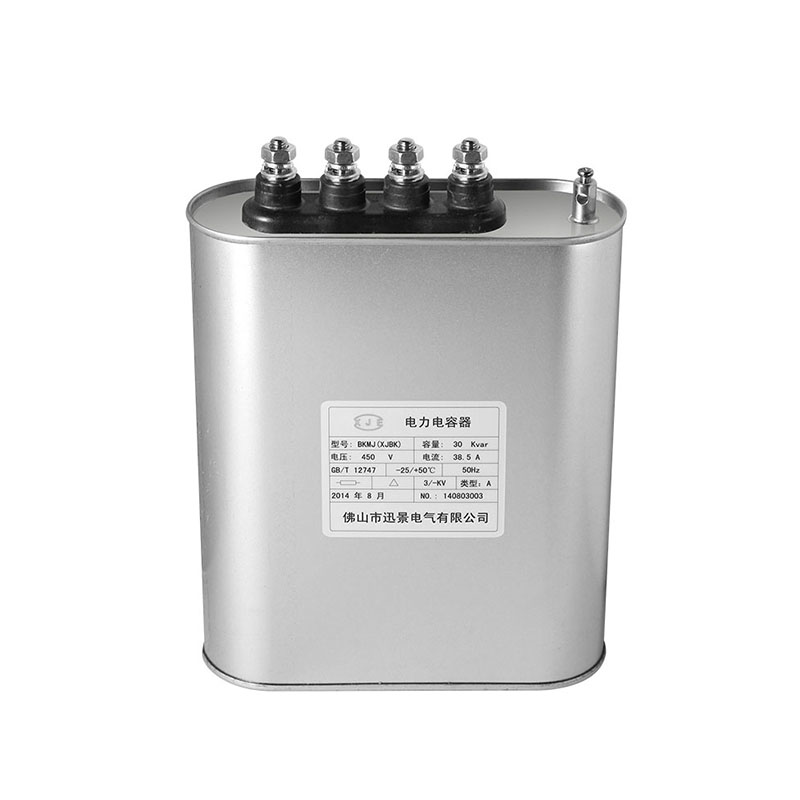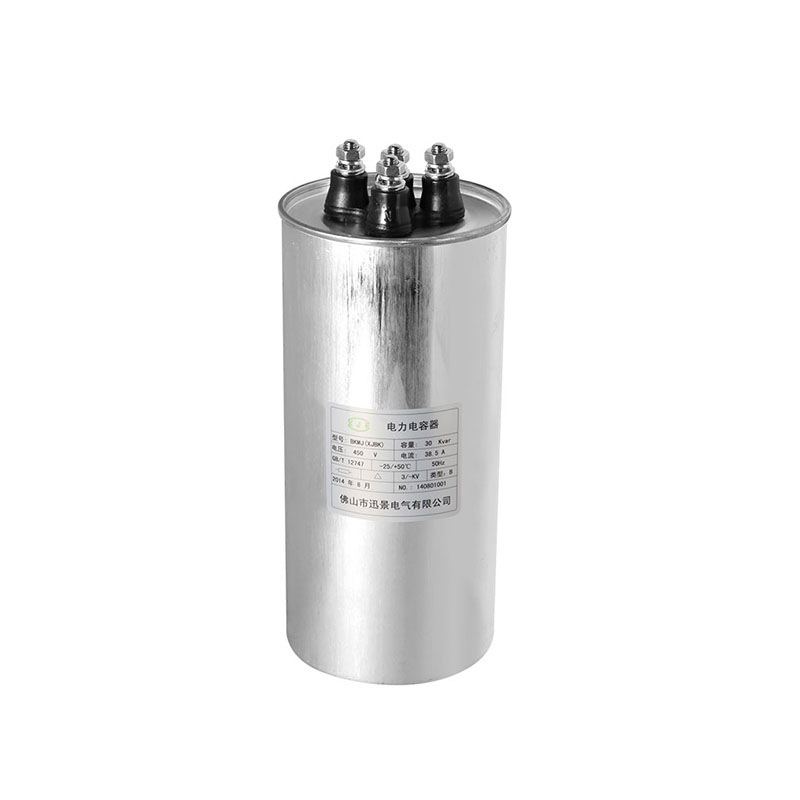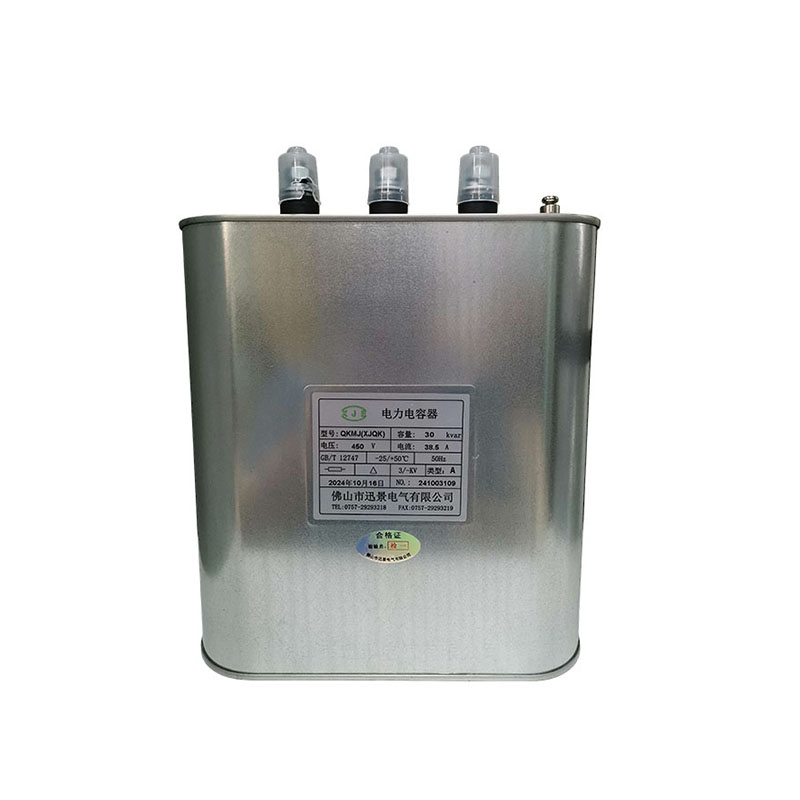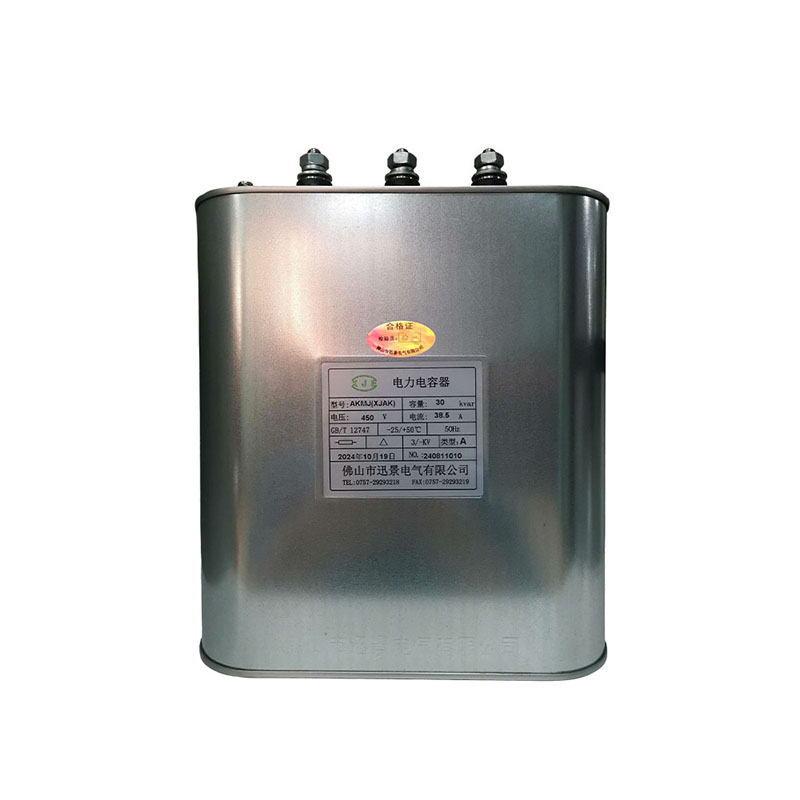How do self-healing low-voltage shunt capacitors improve grid stability and efficiency?
Release Time : 2025-08-12
Self-healing low-voltage shunt capacitors play a key role in improving grid stability and efficiency. Through their unique self-healing technology and optimized design, these capacitors not only effectively compensate for reactive power but also enhance the reliability and efficiency of power systems, bringing significant advantages to modern power grids.
First, the core advantage of self-healing low-voltage shunt capacitors lies in their self-healing function. When a localized breakdown occurs within the capacitor, the metallization layer surrounding the fault point rapidly evaporates, forming an insulating zone that automatically isolates the fault point and prevents failure of the entire capacitor. This self-healing mechanism enables the capacitor to continue operating without impacting system operations, significantly improving the reliability and service life of the device. In contrast, conventional capacitors experiencing similar problems could cause the entire system to fail, requiring immediate maintenance and replacement, increasing operating costs and downtime.
Second, self-healing low-voltage shunt capacitors excel in improving grid stability. Reactive power management in power systems is crucial for maintaining voltage levels. When a large number of inductive loads are present on the power grid, voltage drops can affect the normal operation of equipment. By installing self-healing low-voltage shunt capacitors in parallel, they provide the necessary reactive power support, helping to stabilize voltage levels and ensure smooth operation of the power system under various load conditions. Furthermore, these capacitors can reduce harmonic interference, further improving power quality and safeguarding the proper operation of sensitive equipment.
Furthermore, the design of self-healing low-voltage shunt capacitors contributes to overall grid efficiency. High-efficiency capacitors utilize advanced materials and technologies to reduce energy losses and improve energy conversion efficiency. This means the capacitors maintain stable performance over a wider temperature range and do not significantly degrade in performance due to overheating or aging over time. This low loss characteristic not only saves energy but also reduces operating costs, bringing economic benefits to businesses and utilities.
Notably, the cylindrical B-type design has a significant impact on the heat dissipation performance of the capacitor. Good heat dissipation is a key factor in ensuring long-term stable operation of the capacitor. The cylindrical structure provides a larger surface area for heat dissipation, while the optimized internal layout ensures even and rapid heat distribution. This not only extends the capacitor's lifespan but also reduces the risk of failure due to overheating, enhancing overall system reliability.
Furthermore, self-healing low-voltage shunt capacitors offer excellent interference immunity, which is particularly important for ensuring power quality. Modern power grids are plagued by various sources of electromagnetic interference, such as lightning strikes and switching operations. These interference can cause voltage fluctuations or current distortion, potentially impacting the proper functioning of power equipment. High-quality self-healing low-voltage shunt capacitors, with their built-in protection mechanisms and shielding design, effectively resist external interference, ensuring stable power system operation in complex environments.
The application of intelligent monitoring technology further enhances the capabilities of self-healing low-voltage shunt capacitors. Some advanced models feature real-time status monitoring systems that continuously track capacitor operating parameters such as temperature, pressure, and capacitance. Upon detecting an abnormality, the system immediately issues an alarm and takes appropriate measures to prevent the fault from escalating. This proactive management approach not only enhances equipment safety but also provides a more intuitive user interface for operators, simplifying routine maintenance.
Finally, the explosion-proof design is a key feature of self-healing low-voltage shunt capacitors. In extreme cases, if a serious internal capacitor fault occurs, the explosion-proof design effectively prevents explosion or leakage, protecting surrounding equipment and personnel. This safety design not only meets strict industry standards but also provides users with an additional layer of safety, especially in high-risk environments.
In summary, self-healing low-voltage shunt capacitors play a significant role in improving grid stability and efficiency through their self-healing capabilities, enhanced grid stability, improved overall efficiency, optimized heat dissipation, enhanced anti-interference capabilities, intelligent monitoring technology, and enhanced safety design. Each improvement is designed to provide a better user experience and demonstrates a deep understanding and respect for user needs and social responsibility. In the future, with the continuous emergence of new materials and technologies, self-healing low-voltage shunt capacitors will demonstrate their unique value in even more areas, driving the entire industry to higher levels. Both emerging and traditional industries can benefit from this, jointly creating more efficient, reliable, and environmentally friendly power system solutions.
First, the core advantage of self-healing low-voltage shunt capacitors lies in their self-healing function. When a localized breakdown occurs within the capacitor, the metallization layer surrounding the fault point rapidly evaporates, forming an insulating zone that automatically isolates the fault point and prevents failure of the entire capacitor. This self-healing mechanism enables the capacitor to continue operating without impacting system operations, significantly improving the reliability and service life of the device. In contrast, conventional capacitors experiencing similar problems could cause the entire system to fail, requiring immediate maintenance and replacement, increasing operating costs and downtime.
Second, self-healing low-voltage shunt capacitors excel in improving grid stability. Reactive power management in power systems is crucial for maintaining voltage levels. When a large number of inductive loads are present on the power grid, voltage drops can affect the normal operation of equipment. By installing self-healing low-voltage shunt capacitors in parallel, they provide the necessary reactive power support, helping to stabilize voltage levels and ensure smooth operation of the power system under various load conditions. Furthermore, these capacitors can reduce harmonic interference, further improving power quality and safeguarding the proper operation of sensitive equipment.
Furthermore, the design of self-healing low-voltage shunt capacitors contributes to overall grid efficiency. High-efficiency capacitors utilize advanced materials and technologies to reduce energy losses and improve energy conversion efficiency. This means the capacitors maintain stable performance over a wider temperature range and do not significantly degrade in performance due to overheating or aging over time. This low loss characteristic not only saves energy but also reduces operating costs, bringing economic benefits to businesses and utilities.
Notably, the cylindrical B-type design has a significant impact on the heat dissipation performance of the capacitor. Good heat dissipation is a key factor in ensuring long-term stable operation of the capacitor. The cylindrical structure provides a larger surface area for heat dissipation, while the optimized internal layout ensures even and rapid heat distribution. This not only extends the capacitor's lifespan but also reduces the risk of failure due to overheating, enhancing overall system reliability.
Furthermore, self-healing low-voltage shunt capacitors offer excellent interference immunity, which is particularly important for ensuring power quality. Modern power grids are plagued by various sources of electromagnetic interference, such as lightning strikes and switching operations. These interference can cause voltage fluctuations or current distortion, potentially impacting the proper functioning of power equipment. High-quality self-healing low-voltage shunt capacitors, with their built-in protection mechanisms and shielding design, effectively resist external interference, ensuring stable power system operation in complex environments.
The application of intelligent monitoring technology further enhances the capabilities of self-healing low-voltage shunt capacitors. Some advanced models feature real-time status monitoring systems that continuously track capacitor operating parameters such as temperature, pressure, and capacitance. Upon detecting an abnormality, the system immediately issues an alarm and takes appropriate measures to prevent the fault from escalating. This proactive management approach not only enhances equipment safety but also provides a more intuitive user interface for operators, simplifying routine maintenance.
Finally, the explosion-proof design is a key feature of self-healing low-voltage shunt capacitors. In extreme cases, if a serious internal capacitor fault occurs, the explosion-proof design effectively prevents explosion or leakage, protecting surrounding equipment and personnel. This safety design not only meets strict industry standards but also provides users with an additional layer of safety, especially in high-risk environments.
In summary, self-healing low-voltage shunt capacitors play a significant role in improving grid stability and efficiency through their self-healing capabilities, enhanced grid stability, improved overall efficiency, optimized heat dissipation, enhanced anti-interference capabilities, intelligent monitoring technology, and enhanced safety design. Each improvement is designed to provide a better user experience and demonstrates a deep understanding and respect for user needs and social responsibility. In the future, with the continuous emergence of new materials and technologies, self-healing low-voltage shunt capacitors will demonstrate their unique value in even more areas, driving the entire industry to higher levels. Both emerging and traditional industries can benefit from this, jointly creating more efficient, reliable, and environmentally friendly power system solutions.







